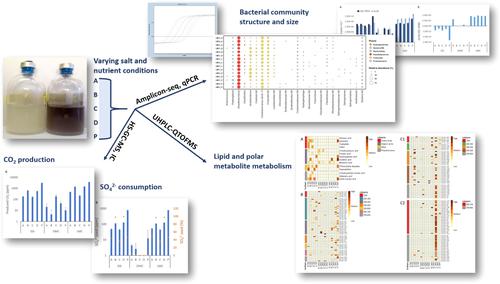当前位置:
X-MOL 学术
›
Environ. Microbiol.
›
论文详情
Our official English website, www.x-mol.net, welcomes your feedback! (Note: you will need to create a separate account there.)
Altering environmental conditions induce shifts in simulated deep terrestrial subsurface bacterial communities—Secretion of primary and secondary metabolites
Environmental Microbiology ( IF 5.1 ) Pub Date : 2023-12-14 , DOI: 10.1111/1462-2920.16552 Merja Herzig 1, 2 , Tuulia Hyötyläinen 3 , Gianni F. Vettese 2 , Gareth T. W. Law 2 , Taavi Vierinen 2 , Malin Bomberg 4
Environmental Microbiology ( IF 5.1 ) Pub Date : 2023-12-14 , DOI: 10.1111/1462-2920.16552 Merja Herzig 1, 2 , Tuulia Hyötyläinen 3 , Gianni F. Vettese 2 , Gareth T. W. Law 2 , Taavi Vierinen 2 , Malin Bomberg 4
Affiliation

|
The deep terrestrial subsurface (DTS) harbours a striking diversity of microorganisms. However, systematic research on microbial metabolism, and how varying groundwater composition affects the bacterial communities and metabolites in these environments is lacking. In this study, DTS groundwater bacterial consortia from two Fennoscandian Shield sites were enriched and studied. We found that the enriched communities from the two sites consisted of distinct bacterial taxa, and alterations in the growth medium composition induced changes in cell counts. The lack of an exogenous organic carbon source (ECS) caused a notable increase in lipid metabolism in one community, while in the other, carbon starvation resulted in low overall metabolism, suggesting a dormant state. ECS supplementation increased CO2 production and SO42− utilisation, suggesting activation of a dissimilatory sulphate reduction pathway and sulphate-reducer-dominated total metabolism. However, both communities shared common universal metabolic features, most probably involving pathways needed for the maintenance of cell homeostasis (e.g., mevalonic acid pathway). Collectively, our findings indicate that the most important metabolites related to microbial reactions under varying growth conditions in enriched DTS communities include, but are not limited to, those linked to cell homeostasis, osmoregulation, lipid biosynthesis and degradation, dissimilatory sulphate reduction and isoprenoid production.
中文翻译:

环境条件的改变会引起模拟深层陆地地下细菌群落的变化——初级和次级代谢物的分泌
深层陆地地下 (DTS) 蕴藏着惊人的微生物多样性。然而,缺乏对微生物代谢以及地下水成分变化如何影响这些环境中的细菌群落和代谢物的系统研究。在这项研究中,对来自两个芬诺斯坎迪亚地盾遗址的 DTS 地下水细菌群落进行了富集和研究。我们发现这两个地点的富集群落由不同的细菌类群组成,生长培养基成分的改变引起细胞计数的变化。缺乏外源有机碳源(ECS)导致一个群落的脂质代谢显着增加,而在另一个群落中,碳饥饿导致整体代谢较低,表明处于休眠状态。ECS补充增加了CO 2产生和SO 4 2−利用率,表明异化硫酸盐还原途径和硫酸盐还原剂主导的总代谢的激活。然而,这两个群落具有共同的普遍代谢特征,最有可能涉及维持细胞稳态所需的途径(例如甲羟戊酸途径)。总的来说,我们的研究结果表明,在富集的 DTS 群落中,与不同生长条件下的微生物反应相关的最重要的代谢物包括但不限于与细胞稳态、渗透调节、脂质生物合成和降解、异化硫酸盐还原和类异戊二烯产生相关的代谢物。
更新日期:2023-12-14
中文翻译:

环境条件的改变会引起模拟深层陆地地下细菌群落的变化——初级和次级代谢物的分泌
深层陆地地下 (DTS) 蕴藏着惊人的微生物多样性。然而,缺乏对微生物代谢以及地下水成分变化如何影响这些环境中的细菌群落和代谢物的系统研究。在这项研究中,对来自两个芬诺斯坎迪亚地盾遗址的 DTS 地下水细菌群落进行了富集和研究。我们发现这两个地点的富集群落由不同的细菌类群组成,生长培养基成分的改变引起细胞计数的变化。缺乏外源有机碳源(ECS)导致一个群落的脂质代谢显着增加,而在另一个群落中,碳饥饿导致整体代谢较低,表明处于休眠状态。ECS补充增加了CO 2产生和SO 4 2−利用率,表明异化硫酸盐还原途径和硫酸盐还原剂主导的总代谢的激活。然而,这两个群落具有共同的普遍代谢特征,最有可能涉及维持细胞稳态所需的途径(例如甲羟戊酸途径)。总的来说,我们的研究结果表明,在富集的 DTS 群落中,与不同生长条件下的微生物反应相关的最重要的代谢物包括但不限于与细胞稳态、渗透调节、脂质生物合成和降解、异化硫酸盐还原和类异戊二烯产生相关的代谢物。



























 京公网安备 11010802027423号
京公网安备 11010802027423号